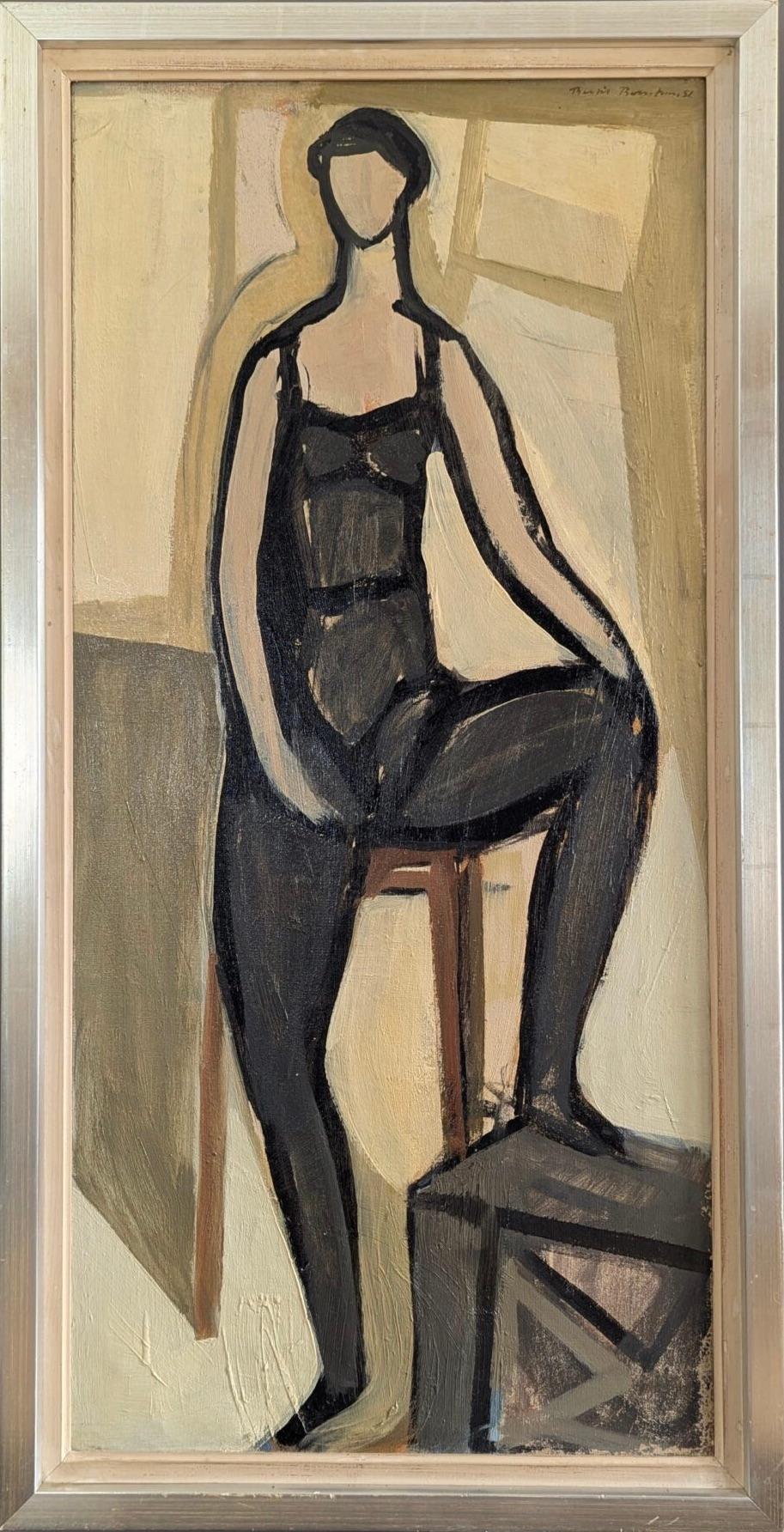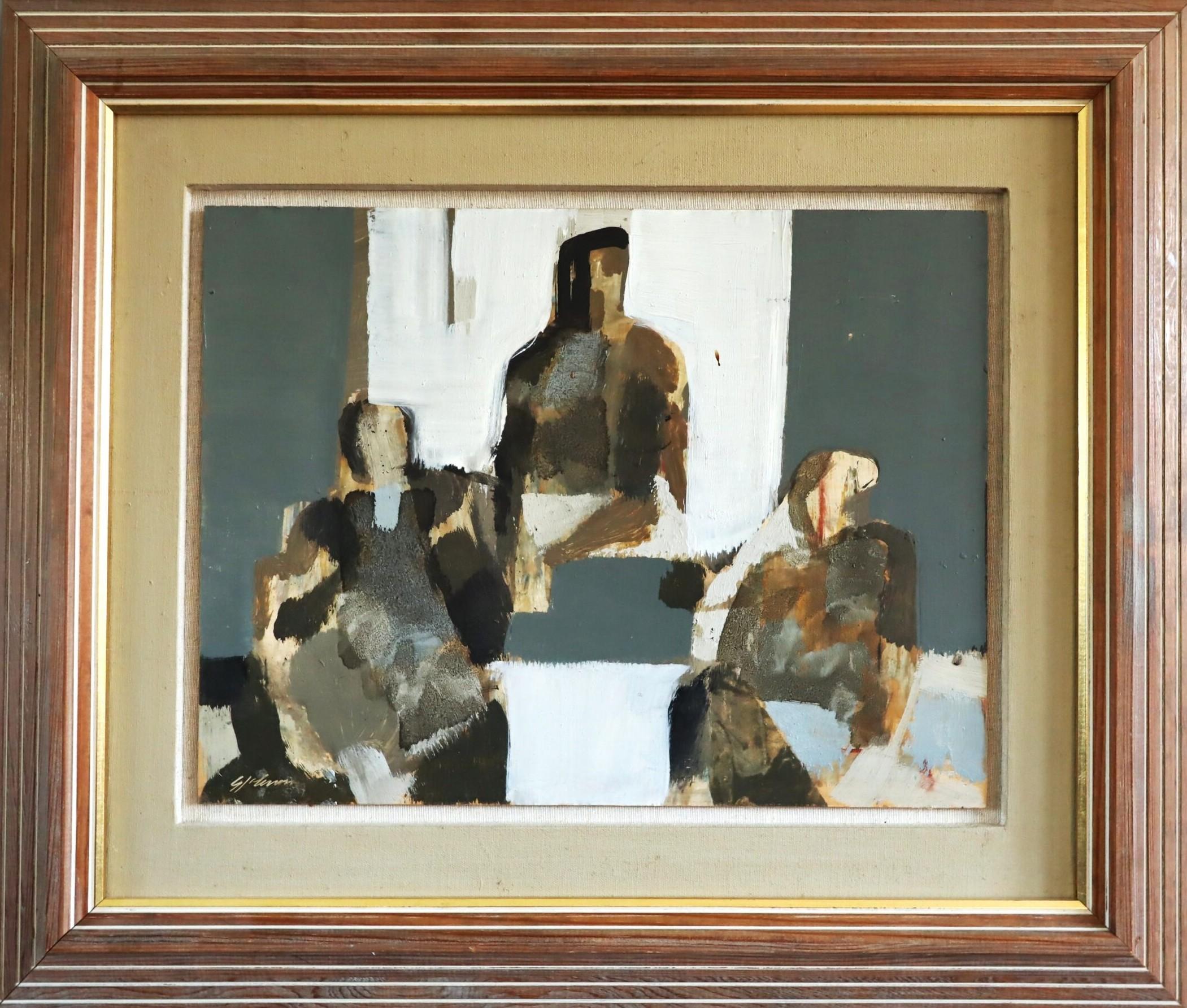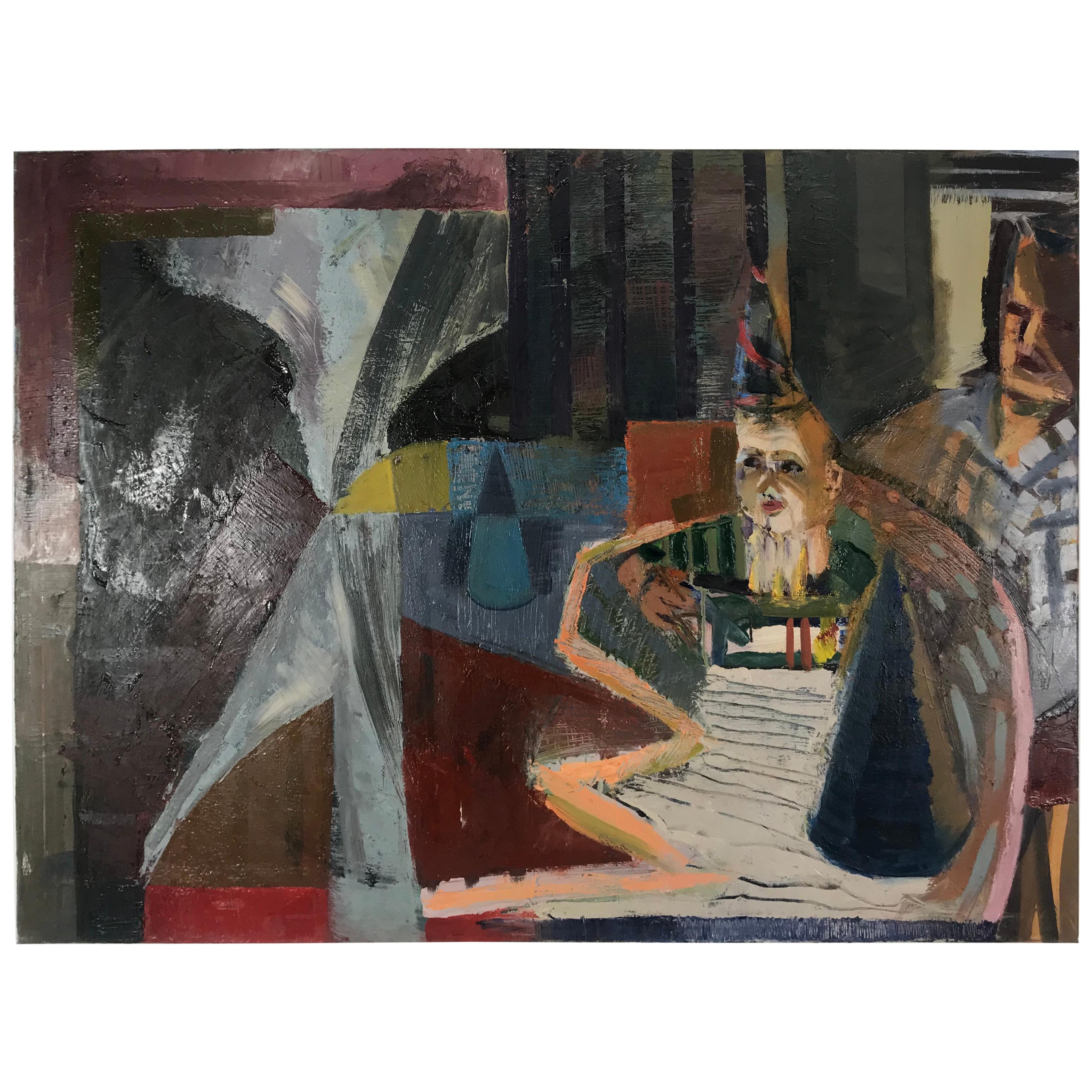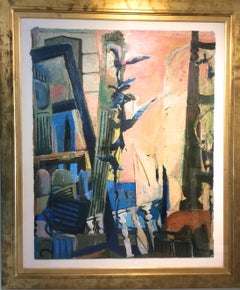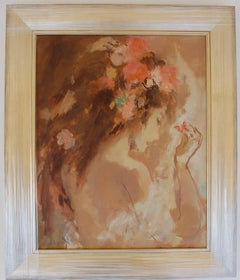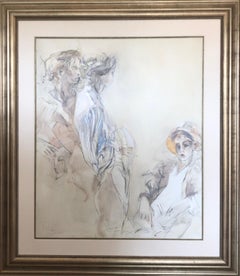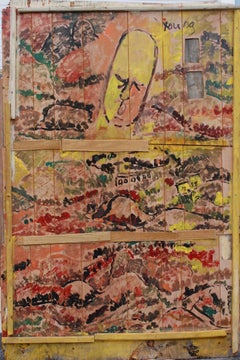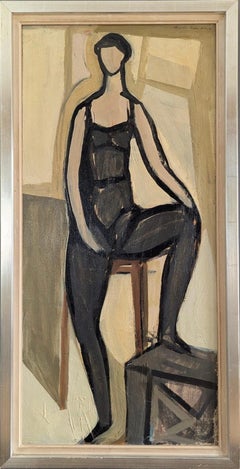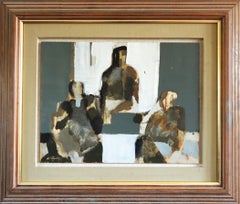Items Similar to Pensive With Nosegay Mid Century Modern Oil Painting
Want more images or videos?
Request additional images or videos from the seller
1 of 9
Jon (Corka) CorninPensive With Nosegay Mid Century Modern Oil Painting1950
1950
$1,400
£1,058.23
€1,216.09
CA$1,949.49
A$2,168.73
CHF 1,136.88
MX$26,501.34
NOK 14,476.69
SEK 13,627.80
DKK 9,077.65
Shipping
Retrieving quote...The 1stDibs Promise:
Authenticity Guarantee,
Money-Back Guarantee,
24-Hour Cancellation
About the Item
Pensive with nosegay -
Painted in Berkeley CA. painting size 10x8 with frame 16x14x1
Jon (Corka) Cornin 1905-1992
Born in New York City on March 24, 1905, Jon Cornin studied in New York City at the Art Students League and the Grand Central School of Art. Using the pseudonym CorKa, he and his wife Zena Kavin produced cartoons for Saturday Evening Post and the New Yorker during 1941-52.
The Cornins moved to the San Francisco Bay area in 1940 and settled in Oakland. He died there on March 12, 1992. He was the author of Painter's Credo: Selected Notes (Stone House Press, 1985).
Exhibitions:
Museum of New Mexico, 1937-39
Oakland Art Gallery, 1939-45
San Francisco Museum of Art, 1938, 1940, 1945
California Water Color Society, 1948-49
Denver Museum, 1946
California Palace of the Legion of Hono
Source: Edan Hughes, "Artists in California, 1786-1940"
Who's Who in American Art 1947.
- Creator:Jon (Corka) Cornin (1905 - 1992)
- Creation Year:1950
- Dimensions:Height: 16 in (40.64 cm)Width: 14 in (35.56 cm)Depth: 1 in (2.54 cm)
- Medium:
- Movement & Style:
- Period:
- Condition:
- Gallery Location:Lake Worth Beach, FL
- Reference Number:1stDibs: LU19224231781
About the Seller
5.0
Platinum Seller
Premium sellers with a 4.7+ rating and 24-hour response times
Established in 2004
1stDibs seller since 2015
328 sales on 1stDibs
Typical response time: <1 hour
- ShippingRetrieving quote...Shipping from: Lake Worth Beach, FL
- Return Policy
Authenticity Guarantee
In the unlikely event there’s an issue with an item’s authenticity, contact us within 1 year for a full refund. DetailsMoney-Back Guarantee
If your item is not as described, is damaged in transit, or does not arrive, contact us within 7 days for a full refund. Details24-Hour Cancellation
You have a 24-hour grace period in which to reconsider your purchase, with no questions asked.Vetted Professional Sellers
Our world-class sellers must adhere to strict standards for service and quality, maintaining the integrity of our listings.Price-Match Guarantee
If you find that a seller listed the same item for a lower price elsewhere, we’ll match it.Trusted Global Delivery
Our best-in-class carrier network provides specialized shipping options worldwide, including custom delivery.More From This Seller
View AllThe Last Mediterranean Hummingbird
By Joseph Norman
Located in Lake Worth Beach, FL
The Last Mediterranean Hummingbird
Size: 51x41 framed under glass 64.5x54.5 x1
Joseph Norman.
The artist created this stunning work of art in Spain in the late 80s; it is from a S...
Category
1980s American Modern Figurative Paintings
Materials
Charcoal, Acrylic, Handmade Paper
Dream Mystique
By Wallace Bassford
Located in Lake Worth Beach, FL
Dream Mystique
Artist signed and titled, new frame canvas 24x20
Wallace Bassford was an American painter and illustrator, born in 1900 in St. Louis Missouri, he attended the St. Loui...
Category
1970s Expressionist Figurative Paintings
Materials
Canvas, Oil
Parade Large Oil Painting
By Jürgen Görg
Located in Lake Worth Beach, FL
"Parade"
Oil, graphite on linen canvas, canvas 46x39 with frame 63x55.
Jurgen Gorg was born in 1951 in Dernbach Germany. His formative years were spent in Koblentz, before moving ...
Category
1980s Expressionist Figurative Paintings
Materials
Linen, Oil, Graphite
Angel Watches Over Them Oil On Wood Panel
By Purvis Young
Located in Lake Worth Beach, FL
Angel Watches Over Them 1977
Oil on wood panel artist signed.
This is a wonderful, example of early Purvis work, signed user right.
Purvis Young (1943-2010) was an American artist fr...
Category
1970s Expressionist Figurative Paintings
Materials
Oil, Wood Panel
Portrait Of A Young Model Work On Paper
By Alexander Rutsch
Located in Lake Worth Beach, FL
Portrait Of A Young Model Work On Paper
Rutsch is always "scribbling and scrabbling." He is an artist of the purest breed—an artist who has no choice but to paint. He is a chosen traveler of the depths of existence; a man who follows a longing to explore his inner self and relate his findings with the energy and identity of the universe.
The celebrated Austrian artist approaches painting and sculpture as he lives life—with the eyes of a child and the hand of a poet. Constantly in the quest for rhythms of form and vibrations of color, he catches those "sparks in the shadow" and evidences their fullest reality and beauty in his creations.
Each of his paintings is a careful construction as it is a spontaneous act of love. While he might attribute certain artistic expressions to "coincidence," his inspiration comes from such diverse sources as: memories, dreams, sounds, numbers, telephone poles and drift wood. Rutsch has an affinity to vibrant colors, strong contours and rich brush strokes which are apparent in his oils, mixed media works and ink drawings. He has a sensitivity to the unusual, the discarded and a fondness for the ugly as well as the chaotic. These, he often transforms into poignant welded steel abstractions.
Rutsch has an aversion to politics, citing dates and expounding upon honors achieved. There is no talk about 'profound symbolism' in his work and as Carlo McCormick writes in the introduction to Rutsch's monograph, "Meaning is not a seed that Rutsch plants, nurtures and then harvests. It is what grows wild in a volcanic swamp of fossilized, decaying and new-born fancies—as an afterthought and aftershock." Alexander Rutsch is not concerned with interpretations; he is, however, passionate about the process of making art and surrenders his entire being as an instrument to the act of creation.
The geometry of his imagination overflows with figures, profiles and penetrating strong eyes—windows to a deeper place. Their vitality and sensuality pulsate through the "dreamscapes" of Rutsch's created worlds. At times romantic, yet always wild with energy, human forms and experiences are essential to the artist's vocabulary.
The son of opera singers and a singer himself, Rutsch speaks of "the art of painting as the art of silence" and the job of the painter "to dedicate himself to the silence." He adds though, "that this silence is the greatest existing sound in the universe." One wonders why then, if painting is "the art of silence," that Rutsch's paintings scream with sound. Sometimes melancholy, sometimes sensual, sometimes dissonant and sometimes whispering, the rhythms are always rich in the celebration of life and our shared humanity.
Painter, sculptor and poet, Rutsch's oeuvre over the past four decades is tremendous. Celebrated and collected especially in Vienna, Paris, Brussels and New York, he studied with renowned teachers like Boeckl and Dorowsky and collaborated with such geniuses as Salvador Dali. Having left Vienna in the fifties, Rutsch moved to Paris and took the city's art scene by storm. There, Picasso was so enthralled with a portrait Rutsch has done of him that, in a state of great excitement, he countersigned it.
Biography
Alexander Rutsch was born in Russia in 1916 but raised in Belgrade, Yugoslavia. After studying voice in Austria he became an opera singer like his parents, but after WWII, Rutsch's love for visual expression propelled him to change careers. He was a painter, sculptor, philosopher, musician, singer and poet. His life as a romantic is reflected in his work, as he sought to perfect his soul and humanity, "I paint my dreams," said Rutsch.
"My dreams are color and life. They soar in my head like millions of symphonies. I can never stop building dreams."
In 1952, after studying under Josef Dobrowsky, Josef Hoffmann and Herbert Boeckl at the Vienna Academy of Fine Arts, Alexander Rutsch received a scholarship to study in France. There he made contacts and began collaborations with his contemporaries, Picasso and Dali. Rutsch said of his experiences with Picasso, "Picasso played a short but important moment in my life in Paris that affected my entire artistic future. I learned from him that it is not important if art is not aesthetically finished. It can be raw, uncooked, rough. If an artist feels he has said it—it is not important to polish or finish it. Because of Picasso, I learned that if I don't feel the need to finish—I don't have to." In 1954 he exhibited his work at the Salon Artistique International de Saceux and won first prize for abstract painting, the first of may awards received during his prolific career.
During the 13 years he lived in Paris, Rutsch exhibited in many prominent galleries there and throughout Europe. In 1958, The City of Paris awarded him the prestigious Arts, Science and Letters Silver Medal. In 1966, Jean Desvilles presented his prize winning film "Le Monde de Rutsch" at the Cannes Film Festival and the Venice Biennial. In 1968 Rutsch moved to Pelham, New York where he continued to work in his studio and exhibit in galleries and museums worldwide.
Rutsch's work, as seen through his mastery of many art forms—sculpture, painting, print-making, and drawing, and a wide variety of other media has been described as "vibrating showers of lines, bold geometries, wounded anatomically rambling scrap-wood skeletons...
Category
1980s Expressionist Portrait Paintings
Materials
Watercolor, Charcoal, Oil Pastel
Intermission Oil Painting
By Arbe Ara Berberyan
Located in Lake Worth Beach, FL
Intermission, woman and guitar
48"x36" framed 66"x54"
Arbe Berberyan Russian/Armenian Artist born 1958. The son of a distinguished artist, and Professor of Art & Design, Ara Berbery...
Category
1980s Modern Figurative Paintings
Materials
Cotton Canvas, Oil
You May Also Like
Vintage Mid-Century Modern Abstract Figurative Framed Oil Painting - Montage
Located in Bristol, GB
MONTAGE
Size: 101.5 x 33 cm (including frame)
Oil on Canvas
A unique elongated and narrow semi-abstract figurative composition, executed in oil onto canvas.
Reminiscent of a film s...
Category
Mid-20th Century Modern Figurative Paintings
Materials
Canvas, Oil
1951 Vintage Mid-Century Modern Figurative Portrait Framed Oil Painting - Pose
Located in Bristol, GB
POSE
Size: 80.5 x 41 cm (including frame)
Oil on Canvas
A brilliantly executed modernist style figurative portrait, executed in oil onto canvas and dated 1951.
The composition feat...
Category
Mid-20th Century Modern Portrait Paintings
Materials
Oil, Canvas
Mid Century Cubic Modern American Figural Painting by Sarno
Located in Douglas Manor, NY
5-3418 Abstract oil on board.
Set in a silvered wood frame
Signed Sarno
Image size 24x19"
Category
1970s Abstract Paintings
Materials
Oil
Mid-Century Modern Vintage Abstract Figurative Oil Painting - Abstract Trio
Located in Bristol, GB
ABSTRACT TRIO
Size: 52.5 x 61.5 cm (including frame)
Oil on board
A mid-century abstract figurative painting that captures a serene and introspective atmosphere, depicting three abs...
Category
Mid-20th Century Abstract Figurative Paintings
Materials
Oil, Board
Large Modernist Abstract Oil on Canvas Looking Forward Looking Back by Fritz
By Fritz Albert
Located in Buffalo, NY
Looking forward, looking back
Fritz proctor is an American painter from Niagara Falls, New York. Fritz acquired his BA in Studio Art from the Universi...
Category
2010s American Mid-Century Modern Paintings
Materials
Canvas, Paint
1957 Vintage Modernist Abstract Figurative Framed Oil Painting- Senoritas
Located in Bristol, GB
SENORITAS
Size: 48 x 62 cm (including frame)
Oil on Board
An outstanding semi-abstract figurative oil composition, painted in 1957 by the established Swedish artist Ivar Morsing (1919-2009), whose works have been exhibited in public collections including the National Museum in Stockholm, Moderna Museet in Stockholm, Kalmar Museum, and Jönköping Museum.
The artwork captures the poised and elegant presence of five Spanish ladies...
Category
Mid-20th Century Modern Figurative Paintings
Materials
Oil, Board
More Ways To Browse
California Mid Century Modern Art
Mid Century New Yorker Art
New Yorker Cartoon Art
William Carlson
Aba Linus
Alejandra Espana
Benin Ivory
Cal Culver
Cream Of Wheat Paintings
Dali 3 Nudes
Evgeniy Monahov
Gabriel Ferrier
John Melville
Liu Xiaodong
Michael Carlson
Michael Thomas Sofa
Mimosa Painting
Oil Painting Jazz Club

